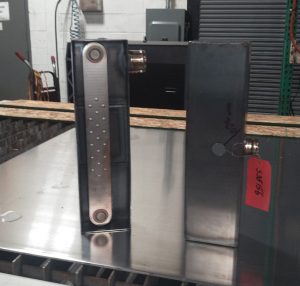
The process of fabricating metal parts involves several techniques and steps to transform raw metal materials into finished components or products. The specific process can vary based on the type of metal, the desired part’s complexity, and the intended application. Here, I’ll outline some common methods used in metal part fabrication.
Fabricating Process
Design and Engineering:
This is the initial phase where the design of the metal part is conceptualized and engineered using computer-aided design (CAD) software. Engineers create detailed 3D models that include dimensions, tolerances, and other specifications.
Material Selection:
Choosing the right type of metal is crucial. Metals like steel, aluminum, titanium, and others have different properties such as strength, corrosion resistance, and conductivity. The choice depends on the part’s intended use.
Material Preparation:
Raw metal materials are obtained in various forms, such as sheets, bars, or ingots. These materials might need to undergo processes like cutting, shearing, or sawing to obtain the appropriate size and shape.
Machining:
Machining involves using cutting tools to remove excess material and shape the metal part to the desired dimensions. Techniques like turning, milling, drilling, and grinding are commonly used in machining processes.
Stamping and Forming:
Stamping involves using a die to press the metal into the desired shape. Also, forming processes like bending, deep drawing, and roll forming are also used to shape metal sheets.
Welding:
Welding joins separate metal parts by melting their edges and fusing them together. Various welding techniques, such as arc welding, MIG (Metal Inert Gas) welding, and TIG (Tungsten Inert Gas) welding, are employed based on the metal type and application.
Assembly:
Once individual metal parts are fabricated, they may be assembled using methods like welding, fasteners (screws, bolts), adhesives, or rivets to create the final product.
Finishing and Surface Treatment:
Metal parts might undergo processes to improve their surface finish, corrosion resistance, or appearance. This can include processes like painting, powder coating, plating, anodizing, or heat treatment.
Quality Control:
Throughout the fabrication process, quality control measures are implemented to ensure that the finished metal parts meet the specified standards. This involves inspections, measurements, and testing to identify defects or deviations from the desired specifications.
Final Inspection and Packaging:
Once the metal parts are fabricated and quality-checked, they undergo a final inspection before being packaged and prepared for shipping or use.
Each step in the metal part fabrication process requires specialized equipment, skills, and knowledge to ensure that the final product meets the desired requirements in terms of quality, performance, and functionality. Finally, contact us today for all your fabrication needs.